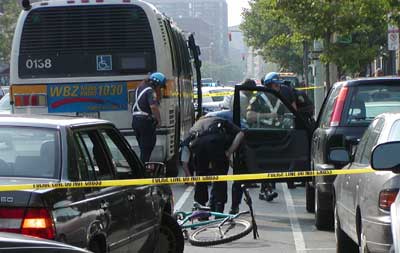
 |
OPINION
By Jesse Gordon July 20 2002
The fatal bicycling accident earlier this month in Central Square indicates that SOMETHING should be done about bike paths in Cambridge. But people disagree on what the SOMETHING should be. I propose that creating a safe bicycle environment requires establishing a city-wide network of on-road and off-road bicycle paths as a long-term solution, and getting more people on bicycles as a short-term solution. The police and merchants generally believe that bicycles hinder traffic. Many police would prefer additional automobile lanes to bicycle lanes, because their focus is on maintaining the through-flow of traffic. Many merchants would prefer additional parking to bicycle lanes, because their focus is on parking near their stores (bicyclists can't even carry as much merchandise as pedestrians or mass transit riders). Bicycle lanes have always competed for roadway width with automobile lanes and automobile parking -- bicycle advocates like me promote bike paths as the best alternative within that context. 
Some bicycle supporters advocate against bike paths, and cite last month's fatal accident as evidence that bike paths offer a false sense of security. "Vehicular cyclists" point out that the cyclist, Dana Laird, was killed while riding fully within a well-marked bicycle lane, by a bus driving within its proper travel lane, while avoiding a car parked properly in a parking spot. They would advocate bicycling fully within the normal automobile lanes, which forces motorist awareness and results in greater safety. Separate bicycle paths defeat the purpose of vehicular cycling, in this view, because such paths diminish motorist awareness and postpone the day when bicycles are accepted as a co-equal transportation form. Vehicular cyclists and regular bicycle advocates usually compromise by seeking marked bike paths on the widest streets first. Mass Avenue where the accident occurred is fairly wide -- not ideal for a bike path, but wide enough to satisfy city and national standards. My colleagues on the Cambridge Bicycle Committee advocate educating both the bicyclist and motorist population. Bicyclists should learn to ride on the outside of bicycle lanes to avoid car doors (had Laird been riding on the outside instead of the inside of the marked lane, she would not have had to swerve around the open door). Motorists should learn to expect bicyclists before opening their doors while parking (had the SUV owner looked before opening his door on July 2, he would have seen Laird and avoided the accident; see accompanying article by Ken Field). While I agree with advocating for safe bicyclist behavior and safer motorist behavior, I see a "chicken-and-egg" problem. Motorists don't expect bicyclists because there are not that many bicyclists, and bicyclists won't be safe until there are enough bicyclists to make motorists expect them. In contrast to American roads, Scandinavian roads offer much greater safety for bikes even in dense urban areas, because the density of bicycles exceeds a critical mass that forces motorist awareness. I see the solution to the chicken-and-egg dilemma that we should try to achieve that same critical mass on the Cambridge roads. I propose two actions: Get out and bike; then tell your representatives about it. On the first action, I propose "Dana Laird Day," that on July 2 every year, every person bike to their destination instead of driving. Laird was biking to meet friends at a Red Sox game at the time of her accident -- an appropriate memorial would be to bike to your pre-Independence Day activities every year. Doing so would flood the streets with bicycles on that day, making motorists aware, and would set the tone for the rest of the summer, both for people riding their bikes and for continuing motorist awareness. On the second action, I propose writing to the Cambridge City Council to describe how you use your bicycle in Cambridge. Hearing from dozens of constituents would let the City Council know that people want more resources dedicated to bike paths. The City Council's role is to balance motorist needs, business' parking needs, and bicyclist needs. Motorists and businesses get themselves heard regularly -- let's get the bicycling constituency heard.
Jesse Gordon is a member of the Cambridge Bicycling Committee
|
| Back to top | |||